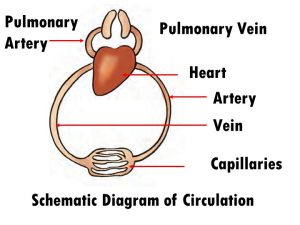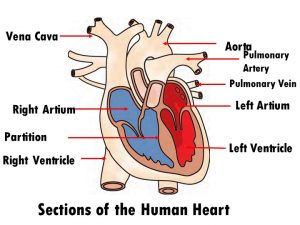Transportation in Animals and Plants
Exercise:
1). Match structures given in Column I with functions given in Column II.
Column I Column II
(i) Stomata (a) Absorption of water
(ii) Xylem (b) Transpiration
(iii) Root hairs (c) Transport of food
(iv) Phloem (d) Transport of water
(e) Synthesis of carbohydrates
Answer:
Column I Column II
(i) Stomata Transpiratiopn
(ii) Xylem Transport of water
(iii) Root hairs Absorption of water
(iv) Phloem Transport of food
2). Fill in the blanks.
(i) The blood from the heart is transported to all parts of the body by the arteries.
(ii) Haemoglobin is present in Red Blood cells.
(iii) Arteries and veins are joined by a network of capillaries.
(iv) The rhythmic expansion and contraction of the heart is called heartbeat.
(v) The main excretory product in human beings is urea.
(vi) Sweat contains water and salts.
(vii) Kidneys eliminate the waste materials in the liquid form called urine.
(viii) Water reaches great heights in the trees because of suction pull caused by transpiration.
3). Choose the correct option:
(a) In plants, water is transported through
(i) xylem (ii) phloem
(iii) stomata (iv) root hair
Ans: xylem
(b) Water absorption through roots can be increased by keeping the plants
(i) in the shade
(ii) in dim light
(iii) under the fan
(iv) covered with a polythene bag
Ans: under the fan
4). Why is transport of materials necessary in a plant or in an animal? Explain.
Ans: All organisms need food, water and oxygen for survival. They need to transport all these to various parts of their body. Further, animals need to transport wastes to parts from where they can be removed. Plants need to transport food from the leaves and water and minerals o all other parts of the plant. For all these transport of materials is necessary in a plant or in an animal.
5). What will happen if there are no platelets in the blood?
Ans: The function of the platelets is to make a clot which prevent the cut to stop bleeding. If there are no platelets in the blood, no clot will be formed and as a result, bleeding will not stop and this leads to a deficiency of blood.
6). What are stomata? Give two functions of stomata.
Ans: Stomata are the tiny pores present on the surface of the leaves. The functions of stomata are as follows.
(i). It enables the excess water to evaporate by the process of transpiration.
(ii). the exchange of gases in plants takes place through stomata.
7). Does transpiration serve any useful function in the plants? Explain.
Ans: Yes, transpiration is useful function in the plants in the following ways.
(i). The evaporation of water from leaves generates a suction pull which can pull water to great heights in the tall trees.
(ii). Transpiration also cools the plant.
8). What are the components of blood?
Ans: Blood is composed of a fluid, called plasma in which different types of corpuscles are suspended. Corpuscles are of three types Red blood cells, white blood cells, and platelets.
9). Why is blood needed by all the parts of a body?
Ans: All organisms need food, water and oxygen for survival which is supplied to them by the blood. Also, blood carries the waste released by all the parts of the body to the organs where they removed out of the body.
10). What makes the blood look red?
Ans: Blood contains three kinds of cells. Out of which Red Blood Cells contains a red pigment called haemoglobin. Haemoglobin imparts the red colour to the blood.
11). Describe the function of the heart.
Ans: The heart is an organ which beats continuously to act as a pump for the transport of blood, which carries other substances with it.
12). Why is it necessary to excrete waste products?
Ans: When our cells perform their functions, certain waste products are released. These are toxic and if accumulated in the body then it is harmful for the body. Hence need to be removed from the body.
13). Draw a diagram of the human excretory system and label the various parts.

Additional Questions:
Fill in the blanks.
(i). Haemoglobin binds with oxygen and transports it to all the parts of the body and ultimately to all the cells.
(ii). The presence of haemoglobin makes blood appear red.
(iii). The two upper chambers of the heart are called atria.
(iv). The walls of the chambers of the heart are made up of muscles.
(v). Veins carry blood from all parts of the body back to the heart.
(vi). A doctor uses the stethoscope as a device to amplify the sound of the heart.
(vii). Aquatic animals like fishes, excrete cell waste as ammonia which directly dissolves in water.
(viii). Plants absorb water and minerals by the roots.
(ix). A tissue is a group of cells that perform a specialised function in an organism.
Write whether True or False.
(i). The presence of platelets makes blood appear red.
Ans: False.
(ii). A resting person, usually has a pulse rate between 72 and 80 beats per minute.
Ans: True.
(iii). The heart has three chambers.
Ans: False.
(iv). The heart is a muscle.
Ans: True.
(v). Animals such as sponges and Hydra do not possess any circulatory system.
Ans: True.
(vi). The way in which waste chemicals are removed from the body of the animal depends on the availability of water.
Ans: True.
(vii). The vascular tissue xylem transport food in plants.
Ans: False.
(viii). Our heart is roughly the size of our clinch fist.
Ans: True.
Distinguish between arteries and veins.
| Arteries | Veins |
| 1. Arteries carry oxygen-rich blood from the heart to all parts of the body.
|
1. Veins are the vessels which carry carbon dioxide-rich blood from all parts of the body back to the heart. |
| 2. Arteries have thick elastic walls. | 2. Veins have thin walls. |
Answer the following in one sentence each.
(i). What is blood?
Ans: Blood is the fluid which flows in blood vessels.
(ii). Write the types of blood vessels.
Ans: The two types of blood vessels are arteries and veins.
(iii). Write the names of the transport systems of plant?
Ans: Xylem and phloem are the transport systems of plant.
(iv). Name the three kinds of cells found in the blood.
Ans: The three kinds of cells found in the blood are Red Blood Cells, White Blood Cells and platelets.
(v). What is the pulse rate of a normal person?
Ans: The pulse rate of a normal person is between 72 and 80 beats per minute.
(vi) Name the organs involved in the excretory system of humans.
Ans: The kidneys, ureters, bladder and urethra form the excretory system in humans.
(vii). Name the constituents of urine?
Ans: Urine consists of 95% of water, 2.5% urea and 2.5% other wastes.
Write the function of:
(i) Platelets
Ans: Platelets help in the clotting of blood in a cut or wound due to which further bleeding stops.
(ii). Haemoglobin
Ans: Haemoglobin binds with oxygen and transports it to all the parts of the body.
(iii). Xylem
Ans: Xylem transport water and nutrients in the plant.
(iv). Phloem
Ans: Phloem transports food prepared by the leaves to all the parts of the plant.
Answer the following in short
1). Write the functions of blood.
Ans: The functions of blood are as follows
(i). Blood transports substances like digested food from the small intestine to the other parts of the body.
(ii) It carries oxygen from the lungs to the cells of the body.
(iii) It also transports waste for removal from the body.
Define:
(i). Pulse rate.
Ans: The number of beats per minute is called the pulse rate.
(ii). Tissue
Ans: A tissue is a group of cells that perform a specialised function in an organism.
(iii). Excretion
Ans: The process of removal of waste produced in the cells of living organisms is called excretion.
Label the following diagrams.
(i). schematic diagram of circulation

(ii) sections of the human heart

Click here for the solutions of
6). Physical and Chemical Changes
7). Weather, Climate and Adaptations of Animals to Climate
8). Winds, Storms and Cyclones
11). Transportation in Animals and Plants
14). Electric Currents and its Effects
16). Water: A Precious Resource
![]()
